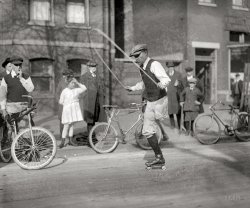
MAY CONTAIN NUTS

Search Shorpy
SHORPY ART

Framed or unframed, desk size to sofa size, printed by us in Arizona and Alabama since 2007. Explore now.
Join and Share
Ad-Free Shorpy
Shorpy is funded by you. Patreon contributors get an ad-free experience.
Learn more.

Recent comments
- Tough Guys
- Lost in Toyland
- And without gloves
- If I were a blindfolded time traveler
- Smoke Consumer Also Cooks
- Oh that stove!
- Possibly still there?
- What?!?
- $100 Reward
- Freeze Frame
- Texas Flyer wanted
- Just a Year Too Soon
- WWII -- Replacing men with women at the railroad crossing.
- Yes, Icing
- You kids drive me nuts!
- NOT An Easy Job
- I wonder
- Just add window boxes
- Icing Platform?
- Indiana Harbor Belt abides
- Freezing haze
- Corrections (for those who care)
- C&NW at Nelson
- Fallen Flags
- A dangerous job made worse
- Water Stop
- Passenger trains have right of way over freights?
- Coal
- Never ceases to amaze me.
- Still chuggin' (in model form)
Member Photos
The Shorpy
Print Emporium
Print Emporium
Search Shorpy
Search results -- 30 results per page
- Western Electric: 1917
- ... factory advertising, not all of the 1912 production bikes had one.
The 61 cubic-inch engine developed 7hp and in ... Posted by Dave - 03/21/2016 - 12:46pm -
![Western Electric: 1917 Oakland circa 1917. "Western Electric Co. -- looking east toward Pacific Tel." For more than a century, the company was the manufacturing arm of Bell Telephone. 8x6 glass negative by the Cheney Photo Advertising Co. View full size.
In the next photoThe wagon, motorcycle, and both cars are involved in an accident. Shorpy taught us this is what happens in Oakland.
The Parapets are Adorned -...with barrels of vegetation, mayhaps to soften the harshness of the stretch metal screens on the windows?
[Sand-filled barrels were placed atop factory roofs for use in case of fire or cartoon violence. - Dave]
Could it Be?A C 1909 Harley V Twin?
(The Motor Bike that is. Thanks Everyone. I just knew Shorpyites would have the answer.)
Ma BellThey built good stuff. I miss the old Bell System, monolithic and overpriced as it was. Now, we have fiber to the home, Skype, too-cheap-to-measure worldwide communications from a pocket phone. All of which was unlikely under Ma's loving embrace (remember Picturephone?).
But Ma brought us UNIX, the cellphone and Telstar.
Thanks, Ma, for getting us started.
Built to LastI still use my 40 year old Trimline Touchtone in my home office. Built like a tank in the USA (until the early 80s and the breakup) and lasts forever. I get the same tactile satisfaction from it as when I use my Nikon and Canon F bodies.
No job is so importantFrom OSPMAG.COM:
The telephone industry has always stressed safety from Day One. From the earliest days, the telephone company was safety-minded. Throughout the Bell System, this motto was displayed everywhere:
"No job is so important and no service is so urgent that we cannot take time to perform our work safely."
I do remember the signs, and we had mandatory "safety meetings" every month.
Western Electric became AT&T Technologies 1984, Lucent in 1996 and then was et up by Alcatel (France) to become Alcatel-Lucent. Their stuff was legendary for reliability, though some thought it a hidden "profit center"' for rate-regulated AT&T.
Built to last and they haveI still use 1960s Western Electric phones for our (hardly used) land lines. The wall phone and desk phone were whatever models first had the # and * on the touch pads.
Yet, in this iPhone age, I still keep my old baby-blue Cap'n Crunch whistle in case it all goes South.
The motorcycleThe flat box on top of the fuel tank, the box behind the engine, and the engine shape make it look to me like an early Indian, like this one:
Could it be? NoThe motorcycle in an Indian v-twin
Mystery locationDoes anyone know where this is? I've trolled all kinds of old manuscripts via Google and can't find any reference to where this exactly was.
Beyond the HarleyThe two cars look to be a 1916 Dodge and a 1915 Type B Saxon
1912 IndianThe motorcycle is a 1912 Indian TT Model, so named for the marque's 1-2-3 place finish in the 1911 International Isle of Man Tourist Trophy race. It can be identified by the straight-down exhaust pipe coming out of the front cylinder. The photo below is of a two-speed model (the shifter is on the top frame tube where it starts to slope downward), and shows the exhaust routing that was unique to the 1912 Indian V-Twin. The long lever with the ball on top controls the clutch—despite factory advertising, not all of the 1912 production bikes had one.
The 61 cubic-inch engine developed 7hp and in racing trim could power the cycle over 80 mph. This year Indian Red paint became standard, although Royal Blue could still be ordered as an option. Other new features on the 1912 Indian were no more bicycle pedals, an extended front fender, an improved coaster band brake, footboards, and the first kick-starter (forward throw) as seen in the bottom photo of a single-speed version that—except for the luggage rack—matches the motorcycle in the main photo.
Location, etc., etc.At the time this photograph was taken, the Oakland branch of the Western Electric Company was at 1900 Telegraph Avenue. Pacific Telephone and Telegraph is behind this building—a block east and half a long block south at 1751 Franklin Street.
(Technology, The Gallery, Factories, Motorcycles)](https://www.shorpy.com/files/images/SHORPY-924A.thumbnail.jpg)
- Speedy Cyclists: 1913
- ... in shorts?
Fixies These guys were riding fixed gear bikes before it was cool... in fact, it was just about their only choice for ... Posted by Dave - 08/23/2013 - 7:36pm -
![Speedy Cyclists: 1913 Christchurch, New Zealand, circa 1913. "Jack Suckling (center right with watch chain) and cyclists outside Speedy Cycle Works, Manchester Street. Champion cyclist Phil O'Shea is third from right." Photo by Adam Maclay. View full size.
No Lycra hereAn old acquaintance owns a couple of large and successful bike shops in Maryland. On his web site [bike123.com] he has a quote from his daughter: "Laurel's famous quote as a toddler was "bike rides are where you see more people in Lycra that shouldn't be!"
Given the thighs on some of the guys, no Lycra needed.
Re: Phil O'SheaMust have been a bit of honor to have Phil O'Shea show up for your picture taking. A very full cycling life.
Suits?I wonder how the guys with jackets and long pants did racing alongside the guys in shorts?
FixiesThese guys were riding fixed gear bikes before it was cool... in fact, it was just about their only choice for another decade or two.
Still thereView Larger Map
Great legs!There are some pretty impressive thigh muscles among that group!
Mr. BeanOn the far right?
David Copperfield's PalIn which Dickens novel was Jack Suckling a character?
Old roadiesAn interesting mix of moustache bars and drop bars here. No brakes, balloon tires on wood rims and wool shorts.
Geez I'm gonna feel like such a wuss the next time I go riding.
Bobby DarinOn the far right?
(The Gallery, Adam Maclay, Bicycles, New Zealand)](https://www.shorpy.com/files/images/SHORPY_FL16643173.thumbnail.jpg)
- Howard's Chicken Shack: 1943
- ... to it since we thought they were cool to have on our bikes.
40 indeed That sure is a '40, for all the reasons you state. ... Posted by Dave - 07/03/2016 - 12:14pm -
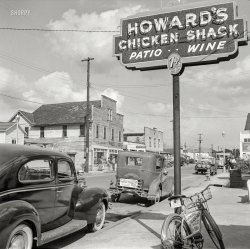
- Garter Girls: 1925
- ... available for the shot. The "step through" frame girl's bikes, once de rigueur for proper young ladies, especially before it became ... Posted by Dave - 08/13/2013 - 4:31pm -
![Garter Girls: 1925 February 7, 1925. Washington, D.C. "Mildred Billert and Hazel Bowman of Ned Wayburn's Revue." National Photo Company glass negative. View full size.
Dangerous poseEven with the kickstand down, I can't believe that was all too stable a position, but it does give the illusion that she's peddling.
[And pedaling. -Dave]
Also not seen much anymoreGirls named Mildred and Hazel are almost as rare as swastika tire treads.
AchtungThe swastika tread design isn't seen much anymore.
Femme PédaleBoth of the ladies are riding "boy's" bicycles. I guess they just grabbed whatever was available for the shot. The "step through" frame girl's bikes, once de rigueur for proper young ladies, especially before it became acceptable for women to wear trousers.
Nice catch rhhardinThe bicycle is a British 1925 Ariel.
Tabloid Musical Comedians
Washington Post, February 1, 1925.
The biggest tabloid musical comedy ever attempted in vaudeville will top the bill at B.F. Keith's theater with the current week, beginning with the matinee today at 3:15 p.m. Ned Wayburn's "Honeymoon Cruise" is the title of this junior musical comedy presented in six big scenes with a score or more of Ned Wayburn pupils and proteges. The book and lyrics were written by Arthur Swanstrom, and the music by Carey Morgan. The membership of the company, all graduates of Ned Wayburn's famous school of dancing, includes James Clemons, Hazel Bowman, Arthur Swanstrom, Mildred Billert, Helen Dobbin, …
Actually,I know a Mildred who is about 30 and a Hazel who is roughly 6! The old names are making a comeback.
(The Gallery, Bicycles, D.C., Natl Photo, Pretty Girls)](https://www.shorpy.com/files/images/SHORPY_12973u.thumbnail.jpg)
- Cycle Cops: 1918
- ... golf course in those outfits. I wonder when fenders for bikes appeared.
Ooohhhh My legs are itching from the sight of those wool ... Posted by Dave - 08/13/2013 - 3:34pm -
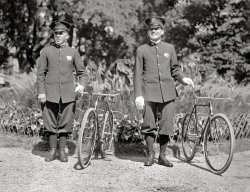
- Garage X: 1946
- ... the little cubbyholes for outdoor toys, sports equipment, bikes, etc. that can be reached without having to go into the garage. That is a ... Posted by Dave - 12/03/2008 - 9:40pm -
![Garage X: 1946 "Experimental housing. Storage shed & garage." Remember that this garage is experimental, and that the slightest little bump could could send the whole business -- prototype potting bench, bleeding-edge tool storage -- pinwheeling off into the next dimension. Eric Schaal, Life photo archive. View full size.
20/20 hindsight neededThat car's rather experimental too. Backing it out of the garage without running the kids over is a crap-shoot at best.
That car is awesome!...but 1946 is pretty late for that streamlined art deco style, isn't it?
Still, if anyone's got that in their closet, and wants it hauled away, just give a whistle and I'll be right over.
Armadillo autoWow!!! That car has some blindspot. It looks like an antediluvian armadillo.
What's wrong with thisWhat's wrong with this picture? In the midst of this minimalist, elegant, modern architectural design of this house/garage comes this huge, ugly tank of a car. Car companies didn't get it then either.
[Hmm. I wonder what kind of car it is. A 1946 Toy ota, maybe. - Dave]
Hubby's HideoutThat's quite a garage. Its almost like a house in itself. I can't tell, but I seem to be seeing a water heater in there, which must mean it also has running water. A man could live there for days if he got into trouble with "the old lady"
That car is amazing too. The trunk is bigger than the interior of the cab. You could stuff another family back there. It also appears to be a garage located on the California coast. Come to think of it, there's an awful lot of little "houses" that resemble this garage that have $800,000 asking prices around parts of where I live out here in San Francisco.
[The round thing is a hatbox. Who'll be the first person to locate this garage on Google Maps? - Dave]
CarAdd a rear window and the car could pass for a 1942 Buick 2 door.
Isn't this just a model?It does not look real. It looks like a model diorama photographed in front of a real landscape.
CubbiesI do love all the little cubbyholes for outdoor toys, sports equipment, bikes, etc. that can be reached without having to go into the garage. That is a nice design.
(Art & Design, Cars, Trucks, Buses, LIFE)](https://www.shorpy.com/files/images/postwar-garage.thumbnail.jpg)
- American National: 1918
- ... right. The more recent Schwinn Heavy Duty or the Worksman bikes look like that.
Sidewalk sidecar Check out the bike with the cargo ... Posted by Dave - 08/23/2012 - 5:35pm -
![American National: 1918 Washington circa 1918. "American National Bank, F Street." Right next door to Harris & Ewing Photographers, who took so many of the photos (including this one) seen here on Shorpy. Harris & Ewing glass negative. View full size.
Still There?Please tell me this wonderful building is still there!
["This wonderful building is still there!" - Dave]
View Larger Map
Victor E. Desio & Co.
Desio & Co. will Remodel Dwelling
Victor E. Desio & Co. have plans prepared by Julius Wenig, architect, for remodeling the three-story and cellar store building at 1309 F street northwest. The entire building, which is 26 feet wide by 82 feet deep, will be remodeled into two stores. The front will be of all glass show windows, marble base and copper trimming. The second and third floors will be fitted out for store and work rooms, and an electric elevator will be installed from the first to third floor. Metal ceilings and marble floors will be a feature on the first floor.
When completed the work will represent an outlay of $8,000. Work will be started July 12, and Victor E. Desio & Co. will occupy the west store and Howard Deane the east store by September 1.
Washington Post, Jul 9, 1916
Victor E. Desio Rites Arranged Here Tomorrow
Victor E. Desio, retired jeweler, who for many years conducted business at 1309 F street Northwest, died yesterday at his home, 2400 Fort Scott Drive, Arlington, Va. He was 64 years old.
Born here, Mr. Desio carried on the jewelry business founded by his father, the late Gerome Desio, in 1874. He was a member of the Holy Name Society and the Lido Civic Club.
Washington Post, Jan 19, 1943
Not Entirely ThereThat wonderful steeple -- was this a cathedral of banking? -- is gone.
Motorized bicycleCheck out the motorized bicycle at the far right. The more recent Schwinn Heavy Duty or the Worksman bikes look like that.
Sidewalk sidecarCheck out the bike with the cargo sidecar in front of the bank! And what are those brass cans on the sidewalk?
[Fire extinguishers. - Dave]
Motor PlacementMotor is mounted on right front fork.
AKA Baltimore Sun Bldg.Originally built for the Baltimore Sun newspaper. Alternate Shorpy view in 1924.
Bank In Sun Building
American National Acquires F Street Structure
The American National Bank has bought the Baltimore Sun Building, the price it is understood, being between $210,000 and $225,000. The bank will remodel the interior of the building, and will take the entire two first floors for its bankroom, giving it one of the largest rooms, if not the largest in the city. The bank will move into its new building in September or October of the present year, the deed for the purchase of the big office building, one of the finest in the city, and one of the landmarks of F street, is consummated practically on the first birthday of the bank, its first year of existence having ended yesterday. The bank has been looking for a new location for some months, its present building on Fourteenth street not being large enough.
...
The building was the first of the "tall buildings" erected in Washington, and when it was built, about twenty years ago, it was the handsomest business buildings in the city. It cost for the actual construction about $340,000.
Washington Post, May 5, 1904
BicycleI see the bicycle, but having trouble locating the motor. Maybe he took it with him while he was shopping.
Motor BikeI'll be. It looks like a Smith Motor Wheel. They were usually mounted at the rear of the bike. I've never seen one up front. Just like the one that the lovey Ms. Young has on her Bug.
Dayton Motor BicycleThat's a very rare Dayton Motor Bicycle. The motor is indeed very similar to the Smith Motorwheel, but it was a version sold by the Davis Sewing Machine Company, makers of the Dayton brand at the time. The engine is in the middle of the front wheel. The patent is here.
(The Gallery, D.C., Harris + Ewing, Stores & Markets)](https://www.shorpy.com/files/images/13912a.thumbnail.jpg)
- Washington Flyer: 1921
- ... "Hell, give us two legs (each) and a couple of those Tarty bikes, we could do that! And what's with that sissy helmet? And why didn't he ... Posted by Dave - 08/13/2013 - 4:09pm -
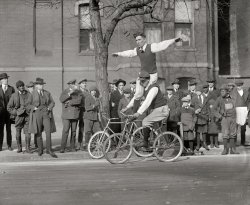
- TTerrace Terraces: 1979
- ... in our back yard and we made little trails to ride our bikes to and from the "house." It was nowhere near as big as this, though. It ... Posted by tterrace - 10/01/2011 - 3:18pm -
![TTerrace Terraces: 1979 Actually, my father's terraces, and there he is at the upper right, at age 77 still taking care of this whole place. Pretty much everything you see here exclusive of the house is his doing. The basic grading had been done by the time my folks bought the place in 1941, but over the years he put in all the pathways, stairs, trees, bushes and other plantings, here as well as the other half of the property. This just most of the back yard, site of the orchard and vegetable gardens. He's preparing one of the three tiers of the latter for planting. I think those are strawberries already sprouting. Later there'd be beans, corn, tomatoes, zucchini and squash. The fruit trees include apples, peaches, plums, prunes, apricots, figs and cherries. The one in the center casting a shadow on the bank of pink-blossoming oxalis is an avocado that grew for decades before finally producing some finger-sized fruit. A row of blackberries follows the stairway, which is lined by amaryllis. When, at the age of 11, I incorporated the yard as the City of Penton, I named those pathways, left to right: Plum Blvd., Compost Rd. (because the compost heaps used to be there) and Garage Ave. (because that's where the stairs went). The square thing above the avocado tree is the platform of my observatory. This Kodachrome slide was at the end of the roll, hence the phantom image of a batch tag or something at the right edge. View full size.
A Natural TalentYour father was gifted as a born landscape architect, although I'm pretty sure he didn't consider himself as such. There is so much to see here, so many facets of gardening are represented and so much hard work that must have taken many years to develop, not to mention the physical effort and time he put in to beautify and create this bountiful backyard. My parents and grandparents did similar cultivation of the earth's rewards, nothing as elaborate as yours, but I did not inherit their penchant for growing things. I wonder if youngsters today even realize that most of their food comes from seeds that require loving care, rain and sunshine to grow into delicious nourishment and/or beautiful flowers (food for the soul). Your father had to be extremely proud of his creation, it is quite magnificent.
What a wonderful place!This would have been an awesome playground for an imaginative kid.
When I was a kid in the '60s we had a playhouse in our back yard and we made little trails to ride our bikes to and from the "house." It was nowhere near as big as this, though. It was also pretty much barren since we lived in the Mojave Desert.
Olde SchoolYour dad was very traditional: you have land, you till it and raise food on it. No square meter was wasted. Classic. It's a great insight into your father and what life must have been like growing up. You were very lucky, Sir.
Your beautiful little churchI looked for it but didn't see it in this picture. Was it in another part of the yard, or am I not looking in the right spot? What nice place to grow up.
Teensy churchThe area with the church is down the hill beyond the left edge of the picture. It'd be obscured by trees and bushes and probably be too small to make out anyway, being only 18 inches tall at most. Oh, and in my recital of vegetables in the garden, I forgot asparagus. Yuck.
A gardening dadTterrace, I love your photos! This reminds me of my dad, who was 74 in 1979. He and my mom both grew up on Norway's Atlantic coast, and my dad was always torn between being a fisherman and being a gardener. So he did both. Our garden was just a little garden behind a little house in a little town in Montana, but I remember sitting out there on summer evenings eating baby carrots, pulled from the ground and washed off under the hose; the Norwegian gooseberries when they were ripe; the beets and turnips and rutabagas and parsnips and all of those things nobody eats anymore. And right next to the garden was his smoker for trout and perch and salmon. Wow. I didn't realize how much I missed it all.
Tterrace, you rock!tterrace, my only childhood regret is not having a kid like you with such an active imagination living next door. Or down the road, in my case [I grew up in the country with the nearest neighbor about 1/4 mile away].
I like the idea of making the backyard an incorporated city, and naming the "streets". Were you the mayor of Penton, or was that your dad's job?
Anyway, keep those hits coming. Always a treat waiting to see what you'll come up with next.
Why the oxalis?What was the reason behind the cultivation of oxalis?
(We classify that as a weed Down Under.)
Was it just that your dad hadn't cleared those garden beds for crops?
Wherefore Oxalis?bhk: My father used to cultivate the slopes of the orchard area by turning over the soil - by hand, with a shovel - each spring in order to control the weeds. A lot of work, especially as one's age advanced. Hell, I griped plenty as a teen when he talked me into helping out. So planting oxalis, and in another area dichondra, accomplished the same thing but without the back-breaking labor. And it looked pretty. Al-Thib: I appointed myself City Manager and Fire Chief, but Mayor and Police Chief were elective offices; Father usually Mayor and Mother Police Chief. There; that ought to reveal something about our family. We also voted in weekly taxes for a while, 10 cents/head, which we later applied to the purchase of a barbecue - er, grill - as seen in an earlier submission of mine.
Oxalis againMy mother used to hate Oxalis because when the leaves/stems were tugged from the soil, invariably the bulk of the little bulbs were left behind to sprout again. Poor Mum would get very frustrated if we kids tried to help by pulling out the plants!
Continuity As glorious as these stepped gardens are, the emotionally upsetting part is wondering, 'What happens to my life's work once I'm not there to do it?' One can only hope there is a Sancho Panza in the wings to give worth to our endeavours.
(ShorpyBlog, Member Gallery, tterrapix)](https://www.shorpy.com/files/images/2418_adj_size2000.thumbnail.jpg)
- ADT Messengers: 1908
- ... supporting the hanging sign.
No Fenders On those bikes. Trust me: you will get very wet on a street with any amount of water. ... Posted by Dave - 08/13/2013 - 4:02pm -
![ADT Messengers: 1908 A. D. T. Messengers, August 1908. Location: Indianapolis, Indiana. (ADT, or American District Telegraph, was the forerunner of today's home security company.) Photo by Lewis Wickes Hine. View full size.
ADTFinally, now I know what ADT stands for, even the people working there today didn't know what ADT stood for. Thanks to Shorpy, now I know.
Well at least some of us do...I am a current ADT employee
American District Telegraph locationI found a copy of the 1909 Indianapolis City Directory and located ADT's office at 29 Monument Circle (formerly known as 'Monument Place'). This is on the southeast quadrant of the Circle.
See the Google pic below: The location is now occupied by the Indianapolis Power & Light headquarters (1 Monument Circle). The marquee of the Circle Theater next door can be seen, the address of which is 45.
I also included a section from the City Directory for 'Telegraph Companies."
{edit] I came across a wider shot of this same corner, taken in 1905. At the time, the building on the right is where Western Union had their offices. The next building over was called the Rhodius Building and contained the Circle Park Hotel.
Look closely at the gap between these two buildings. It and the building to the right are also in the ADT photo. The white pillar can be seen on both views, as can the ironwork supporting the hanging sign.
No FendersOn those bikes. Trust me: you will get very wet on a street with any amount of water.
(The Gallery, Bicycles, Indianapolis, Kids, Lewis Hine)](https://www.shorpy.com/files/images/03227u.thumbnail.jpg)
- The 1960 Look
- ... miss those days. As a teenager in the 50's, riding our bikes to the local dealers to check out the new models. Sneaking to the rear of ... Posted by Dave - 07/01/2016 - 2:46pm -
![The 1960 Look July 1959. "Detroit's 1960 look. Sneak preview of the new models." This particular example being a Dodge Polara convertible minus some ornamentation. 35mm color transparency for Look magazine. View full size.
When chrome was chrome!Mmmmmm....real factory chrome. Not the "stick-on, bits and bobs",found all over the "dee-luks" dealer add ons these days.
More PolestarThe 1960 Dodge Matador also used the polestar trim in the same location, but there wasn't a Matador convertible. The Matador was a one year only model that filled the price gap between the lower priced Dart and the top of the line Polara. Almost 28,000 were produced among four different models (2 sedans, a coupe, and a station wagon). A Matador coupe is below.
ChangeKeyword for American Auto Design during this period. Always new and fresh. When showroom windows would be covered with paper during the late fall when next years models were due. And most foreign cars would carry on with no major exterior changes, but often, lots of small internal improvements. VW was fond of such an approach. Same car as last year with 58 changes was a typical VW style advert.
Description CorrectionThis 1960 Dodge Polara displays the complete correct standard trim for its model. There was OPTIONAL lower body trim that included what car guys generally call a wide bright stainless "washboard" behind the rear wheel well but again, that was an option. Great color photo. Glad you posted it.
["Correction" correction: It's missing the fin ornament. You can see the four holes where it's supposed to go. - Dave]
FinsNot people from Finland either.
I guess the space race had a lot to do with this look!
I miss those days.As a teenager in the 50's, riding our bikes to the local dealers to check out the new models. Sneaking to the rear of the dealers lot to see the yearly changes, never disappointed.
In-house previewI worked at Chrysler Canada as a tradesman in the 1960s and got a first hand preview of the new models as we were doing plant "changeovers".
I couldn't tell you what was coming or I'd have to kill you.
Correction correctionI know my eyesight is becoming more unreliable, but for the life of me I cannot see the screw holes where the missing tail fin is to be attached.
[There is no "missing tailfin." The tailfin is missing an ornament -- a stylized compass rose pointing way to the car's namesake of Polaris, the North Star. Another aspect of the contemporary fad for all things Arctic after Alaska's admission to the Union in 1959. - Dave]
Those were the daysBack when you could identify a car as it passed you on the street.
(The Gallery, Kodachromes, Cars, Trucks, Buses, LOOK)](https://www.shorpy.com/files/images/SHORPY-09869u1.thumbnail.jpg)
- Cruisin' 1968
- ... kill before my parents were ready to leave. We'd ride our bikes in the street in front of our house, play catch (either baseball or ... Posted by bhappel - 09/13/2011 - 1:38pm -
![Cruisin' 1968 Indianapolis, 1968. My brother Dan on his Schwinn along with sister Beth on her trike, in the alley next to our house. Our cousin David is back by the fence. We were all dressed up for our youngest brother's Baptism. View full size.
Me TooI also had a Schwinn bike. Mine was green and I seem to remember it being much heavier than the one in the picture. Me and that bike went all over Brooklyn and out over the Marine Park Bridge (now the Gil Hodges Bridge) to Riis Park back in the '60's.
Thanks for helping me to remember!
Memories of the mid-1960sThis picture really takes me back to the mid-60s when my brother and sister and I would be ready for church, but still have some time to kill before my parents were ready to leave. We'd ride our bikes in the street in front of our house, play catch (either baseball or football) or play tag.
The CousinGrowing up I was fortunate to have many cousins in the neighborhood. Two of my mothers three sisters and my father's two brothers and his sister lived within walking distance. I grew up with eight cousins (there were two more in Boston) and that extended family supported each other (and grandparents) through the hard times of the 30s, the war and old age. The next two generations were not nearly as close and now live across the breadth of this country as well as Europe and Asia.
Love the kickstandIt looks like he's actually riding the bike, until you zoom in on the larger version where you can see the kickstand holding him up. Funny! I love little details like that in these older photos.
I'm confused...Did you and your brother & sister have the same Dad? The previous picture shows your father on a tricycle in 1963, looking younger than your sister did in 1968.
[You'd be less confused if you looked at the "Submitted by" tag above each photo. - Dave]
Trusting ParentsI was 8 years old in 68, so I too know what it is to dress up in "nice clothes" to go someplace important. I my case Disneyland was an every-other-month event. Mom always got me ready first, and rather than turn me loose to play, made me sit on a couch for the half an hour it took her and Dad to get ready.
The worst part was that the TV was in the den (just one set in the house, thank you) and I was always made to sit on the Ethan Allen sofa in the living room, clad in stiff plastic slipcovers where she could keep an eye on me.
Time never dragged so slow as waiting on that dull, hot, uncomfortable sofa, and there would be words if I squirmed so much she had to tuck in my shirt a second time.
The kid in the backgroundI remember childhood from the perspective of the kid in the background. Involved, but not quite, if you know what I mean. The last kid to be picked for kickball, waiting hands in pockets.
Re: Kid in the backgroundI can't fully speak for my cousin David, but I expect that his expression and mood stem from: having to dress up in "good" clothes / going to church not on a Sunday / going to Aunt & Uncle's house where he has to behave and can't get to his toys / not getting attention from our Aunt Lee who was photographing my family more than he and his siblings (my profile photo is also from this same day).
And farther in the background, my father can be seen in the front yard setting his 35mm camera, likely getting a picture of Jim's godparents. Jim's godfather? Why, it's cousin Steve, seen here on Shorpy some 20 years earlier!
Pink and WhiteMy Schwinn bike came to me on a cold snowy Christmas morning in 1960 or 1961 in Colorado. Pink and white with streamers coming out of the handlebars. There was a push button horn in the middle framework of this "lady's bike". My beloved father shoveled the snow outside our house to the corner so I could ride it up and down that short distance. I was 6 and I remember it as if it were yesterday.
(ShorpyBlog, Member Gallery, Kids)](https://www.shorpy.com/files/images/Img6c.thumbnail.jpg)
- Biking in Suburbia: 1968
- ... for kids to explore the nearby hills. We learned to ride bikes, spend weekend mornings hiking the hills, and staying away from our ... Posted by Mvsman - 06/28/2014 - 10:55am -
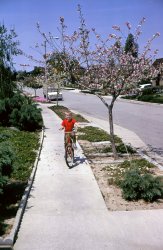
- Bureaucrat in Autumn: 1942
- ... days people sometimes block them off with a gate and store bikes etc in them. In the north of England there is often a back street as well ... Posted by Dave - 07/31/2012 - 2:50pm -
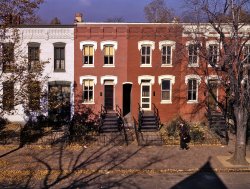
- Expect Delays: 1939
- ... early '70's and my friends and I all had street legal dirt bikes that we rode all the county and environs. It was all farm roads and four ... Posted by Dave - 11/28/2017 - 7:54pm -
![Expect Delays: 1939 January 1939. "Highway in Franklin County, Illinois." Medium format negative by Arthur Rothstein for the Farm Security Administration. View full size.
Illinois backroads.I was stationed at Chanute AFB in Champaign County, Iliinois in the early '70's and my friends and I all had street legal dirt bikes that we rode all the county and environs. It was all farm roads and four digit state roads, mostly unpaved, that allowed us to go just about anywhere without traveling on a paved road for miles. Great fun!
Two signsI think I'd turn around, head back the way I came and not take any chances.
L.E. DirdenLoren Edgar Dirden was born in 1890 in Carmi Illinois and died in 1967 in Franklin County Illinois. A draft card from 1941 can be found in a document called "Old Mans Draft Cards, Franklin County Illinois". He was 51 at the time.
"Expect Delays"This is where any road gets interesting!
Terrible TwosdayWell, between this and the foregoing Private Entrance: 1936, it looks like a good day to have pulled the covers over one's head and maybe try it again on Wednesday.
Canary in a Coal MineFranklin Co. was a bustling hub of mining when this photo was taken. More than a dozen mines operated then, including the one seen in the background here, providing rapid count growth in the early part of the 20th century. It also made for a poignant tie to the sign in the photo, "Prepare to meet thy God," as 119 miners lost their lives at the Orient #2 mine on Dec. 21, 1951 due to a methane gas explosion. There was only one survivor.
Going PostalThe front mail box belongs to an H. Butler. In the 1940 census, there was a Hershal Butler living on an "improved road" running west from Hwy 37 and near the Bethel Church, still extant on a route now bisected by I-57. In between the main route and that rural road was the Orient #2 mine mentioned in a prior comment. It's a fairly safe bet that the mine from the 1951 Franlin Co. tragedy is the one depicted in the background here. Fortunately for H. Butler, he was not amongst its victims. He died in 1949.
Mail box questionThe smaller mail boxes with the flapper make sense. One can padlock the box at the top and still receive mail kept from prying eyes. I cannot see what the purpose of the ability of pad locking the type like the large one and getting no mail. Bombs?
[That assembly at the front top of the box isn't for a lock - the lower section serves as a handle for opening the door and also as a latch to secure closure when engaged with the upper part. A lock requiring the carrier to have key in order to deliver mail into a box isn't permitted. -tterrace]
(The Gallery, Arthur Rothstein, Cars, Trucks, Buses, Railroads, Rural America)](https://www.shorpy.com/files/images/SHORPY-8b17426a.thumbnail.jpg)
- Speed Demon: 1938
- ... motorcycle show two weeks ago in Phoenix. One of the bikes on display was an old Indian that was well decorated over the years by ... Posted by Dave - 03/28/2008 - 1:08pm -
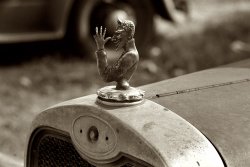
- Indian Curios: 1908
- ...
Bike parking Fascinating how they parked their bikes at this time, there seems like a short kickstand.
It also seems that ... Posted by Dave - 05/23/2019 - 10:05am -
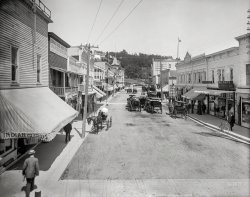
- Crossings: 1908
- ... at 5 a.m. Ah, the days before angry hipsters on their bikes with whistles blowing at tourists trying to enjoy the skyline.
Free ... Posted by Dave - 08/13/2012 - 7:15pm -
![Crossings: 1908 New York circa 1908. "Brooklyn Bridge." It seems like only 38,000 yesterdays. 8x10 inch glass negative, Detroit Publishing Company. View full size.
The Bridge is for sale, by the wayI'll make you a real good deal.
Nothing has changed but the clothingI would suggest that all visitors to New York take a stroll over the Brooklyn Bridge. It's a classic.
John Roebling tried out some of his ideas for the Brooklyn Bridge on a smaller bridge he had been commissioned to build in Waco Texas. I've been there, and it does look something like an adobe copy of the Brooklyn Bridge.
That beautiful bridgeI have lived in New York for many years, and have crossed the bridge many times. But I still look at it with awe and wonder and delight every time I see it. It's just a beautiful work of art. And I've walked across it a few times, too (a highly recommended activity). The last two times I walked across the bridge were 9/11 and that last big New York blackout.
1907/08Both Singer and City Investing Buildings are still under construction. So the year is more like 1907 or 1908.
[Excellent observation. - Dave]
SerenityTo enjoy a scene like this nowadays, one would have to walk the bridge at 5 a.m. Ah, the days before angry hipsters on their bikes with whistles blowing at tourists trying to enjoy the skyline.
Free bridge!Taking the subway to Brooklyn and walking back to Manhattan is one of my favorite free tourist excursions in NYC.
(The Gallery, Boats & Bridges, DPC, NYC)](https://www.shorpy.com/files/images/4a18743a.thumbnail.jpg)
- All Nite: 1941
- ... "J. C. Higgins" sometime after WW II. Elgin-labelled bikes were manufactured by Columbia Westfield Mfg, and I've read that there was ... Posted by Dave - 08/13/2013 - 3:30pm -
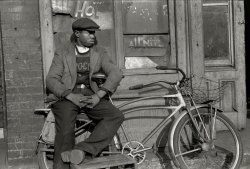
- Percy Neville: 1913
- ... angle.
When you see bars dropped down really low, the bikes were called "scorchers" -- really popular before WWI (possibly later ... Posted by Dave - 08/13/2013 - 4:11pm -
![Percy Neville: 1913 November 1913. Shreveport, Louisiana. "Percy Neville, 11 years old. Messenger boy #6 for Mackay Telegraph Company. He has been messenger for different companies for four years. Goes to the Reservation [red light district] every day." View full size. Photograph and caption by Lewis Wickes Hine.
HandlebarsInteresting; I don't believe I've seen exactly this "gull-wing" style before. These mustache bars are a modern recreation of an early 20th-century style.
Denny Gill
Chugiak, Alaska
Urgent businessThe standard comment about these messenger boys is, "Has been to the Reservation." Can someone please tell me who is sending telegrams to cathouses and why?
[If the cathouse doesn't have a telephone, you send a telegram by messenger. - Dave]
HandlebarsThis style handlebar is actually hinged in the center so you can adjust the angle.
When you see bars dropped down really low, the bikes were called "scorchers" -- really popular before WWI (possibly later too). There are a lot of bicycle photos on Shorpy showing this.
I love this photo.
(The Gallery, Bicycles, Kids, Lewis Hine)](https://www.shorpy.com/files/images/05548u.thumbnail.jpg)
- Camping in Quebec: 1959
- ... buds, heading off for a weekend of camping, riding their bikes on two-lane blacktop and gravel back roads in the Eastern Townships, ... age of these boys -- in the mid-1960s. The tires on these bikes aren't the ultra-fat ones I think of from the 40s and 50s. (I got a ... Posted by Islander800 - 11/14/2014 - 7:38pm -
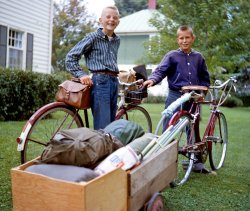
- On the Street Where You Live: 1900
- ... park's fountain is sadly no more.
Nice rack For bikes!
Fast Shade Any idea of the address? I'd like to find out when ... Posted by Dave - 08/15/2012 - 2:39pm -
![On the Street Where You Live: 1900 Detroit, Michigan, circa 1900. "W.H. Jackson residence." Just out of view across 2nd Avenue in this two-part panorama was the residence of Detroit Publishing photographer William Henry Jackson. 8x10 inch glass negative. View full size.
PhotomergeJust thought I'd run both of these through Photoshop's Photomerge command and see what the resulting panorama would look like.
[I tried the same thing (click below to enlarge). A passable result with a couple of obvious flaws -- the cable running across the street, instead of meeting in the middle, diverges at two very different angles, and the curbs on the left side of the street don't line up. Your version (bottom pic) turned out better, curbwise. UPDATE: I took another stab at it and came up with something a tad more Euclidean. Click to embiggen. - Dave]
Cass Park in the backgroundI think this picture is a view of 2nd Avenue heading away from downtown where it runs into Cass Park. I don't think any of these buildings still stand. And the park's fountain is sadly no more.
Nice rackFor bikes!
Fast ShadeAny idea of the address? I'd like to find out when this neighborhood was platted and developed, to get an idea of the age of the trees. Elms, besides having wonderful canopies, also are fast growers.
[Building on the left is the Marlborough apartments at 419-421 Second Avenue. (Addresses have been renumbered since this photo was made.) At the end of the street we can see the fountain in Cass Park. - Dave]
LocationThis looks like the street, from a 1895 Detroit street map.
(The Gallery, Detroit Photos, DPC, W.H. Jackson)](https://www.shorpy.com/files/images/4a20020a.thumbnail.jpg)
- Rollfast Redux: 1959
- ...
The Folly of Youth I cringe when I think of all the bikes that I destroyed as a kid. We all thought that the fancy stuff was for ... Posted by jckazoo - 02/04/2018 - 11:11am -
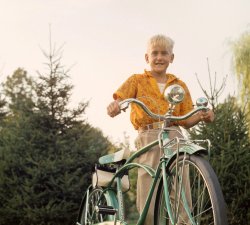
- Inflationary Pressure: 1936
- ... than this kid. I have lived in the far east and have seen bikes like this carry 3-4 people and very, very other heavy cumbersome loads ... Posted by Dave - 08/13/2013 - 3:39pm -
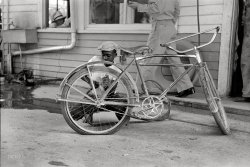
- Postal Boys: 1911
- ... the center bike with the auto horn and spring seat, these bikes look like they had earlier been board track racers.
Bare bones frame ... Posted by Dave - 08/13/2013 - 3:59pm -
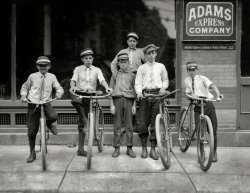
- Motor Maid: 1962
- ... go anywhere without one. I rode Enduros and a few street bikes for many years. But back to my mom. She would get together with anywhere ... Posted by Dave - 06/03/2013 - 10:40am -
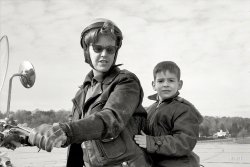
- West of Fargo: 1939
- ... after a few days and spent the rest of the summer riding bikes with my pals. Also, a complete lack of talent may have doomed my career ... Posted by Dave - 08/27/2018 - 9:10pm -
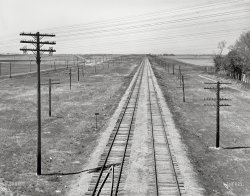
- Hudson Ohio 30's
- Known as the Velocipede, these bikes were used on the railroad for track inspectors and many other employees. ... Posted by Agent 47 - 05/16/2007 - 11:07pm -
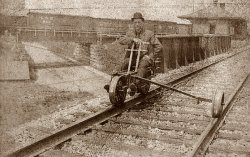
- Catalina Island: 1965
- My sister and me, riding away on rental bikes on California's Catalina Island in June 1965. Kodachrome slide by Dad. ... Posted by rsyung - 08/17/2015 - 10:07am -
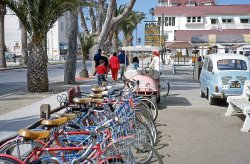
- Sk8r Dude: 1921
- ... View full size.
Cool I like the look of those rad bikes.
The Herb and Joe Show I keep coming back to these photos of Herb ... Posted by Dave - 08/13/2013 - 4:10pm -
